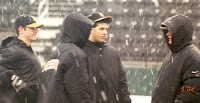
H is for Home Games
The SEC is notorious for scheduling a ton of home games each year.
For example, Georgia's 2012 schedule has 37 home games out of 56 (66%), as does LSU. Only three of LSU's road games are out of conference, and all three of those are within the state of Louisiana..
Arkansas' 2012 schedule features "a school record 36 regular season home games, including 20 of the first 23 games at home." Mississippi State also boasts 36 home games.
Florida and South Carolina have 35 home games, Alabama, Auburn, Tennessee and Vanderbilt have 34, Ole Miss has 32. (Kentucky has not released their 2012 schedule - they had 33 home games in 2011)
Compare the 2012 schedules of Texas (32 home games), Ohio State (26) and Michigan (21).
Why are SEC schedules so home-heavy? Because they can be. First, their weather in the first few weeks of the season trends warmer than it does in many other parts of the country, so teams from colder climates need to schedule games in SEC-country. Also, those same teams want the experience and RPI boost of playing against the SEC.
On the other hand, the NCAA is making changes to the RPI formula that will put a bit higher premium on results in road games. This might lead to some changes in scheduling philosophy when the SEC sees how this affects their rankings. See also The Proposed New RPI (boydsworld.com) and Alternative Futures (sebaseball.com)
So how does this affect MU? Columbia's early season weather is not as favorable as the rest of the SEC, being the northernmost SEC school. So just moving to the SEC doesn't mean Evan Pratte's going to have any better advantage in trying to pad the Tigers' home schedule.
Then again, he's doing a pretty good job at this in spite of MU's semi-northern location. Mizzou's 2012 Schedule includes 33 home games (60%) - more than Ole Miss.


















